Our 10 Keys to Success is a proven methodology to assess the effectiveness of your current efforts and prioritize investments in new communications. Employee benefits communication is vital—to your organization and your people. Our 10 Keys helps ensure your efforts are creating the most value for both.
 We created the 10 Keys based on our work with large employers since 2016. It includes everything you need to know about having the right foundation in place to support your efforts, taking a marketing approach to year-round communication and aligning the right budget and resources.
We created the 10 Keys based on our work with large employers since 2016. It includes everything you need to know about having the right foundation in place to support your efforts, taking a marketing approach to year-round communication and aligning the right budget and resources.
Sign up to have a one-on-one consultation. You’ll get an in-depth review of the 10 Keys with one of our senior consultants and a full C-Suite-ready report on how your organization is doing. The report costs $5,000 and we have a limited number of slots available each month.
Contact us about working together. We take all of our new clients through a robust strategy and planning process, which includes a full assessment. See more about what we do.
When it comes to communication, forget the cost and think about the value. Benefits leaders have an amazing opportunity to impact the lives of their employees in a positive way through the programs they design and provide—if employees actually use those programs. But, while they want employees engaged year-round, they often don’t do what’s needed to make that happen: communicate effectively about the benefits they offer.
Benefits are a huge investment at every company. In fact, 34% of CFOs view health benefits as an important tool for achieving strategic goals: attracting, retaining, and engaging talent; helping employees become better health care consumers; and helping employees better manage their health.
Getting employees to engage in the right programs at the right time helps generate a return on that large investment, but requires a knock-out benefits communication game plan. One of the barriers to investing in communication is the lack of confidence around proven approaches to successful benefits communication. But we know what works. Through our research and engagements with large employers, we have developed a 10-key framework that—when used correctly—results in benefits communication plans that get employees to engage in the right programs at the right time.
The good news is, applying this framework to your benefits communication is easier than you think! In our book, Unlocking Successful Benefits Communication | A 10-Key Framework Every Organization Needs to Get Results we offer a blueprint for envisioning, planning, and implementing effective communication, as well as practical tips for applying each key to your organization. We are sharing the contents of our book with you below, and you can also fill out the form and download the book PDF.
Your communication strategy outlines why you are communicating and how you will do it. Your strategy doesn’t have to be a complicated or long document, but it does need to outline your goals, who you are communicating with, how you’ll reach them, and when you’ll engage with them.
The result of bad communication is a disconnection between strategy and execution.
—Chuck Martin, former vice president, IBM
Before we get into the heart of strategy, we need to talk about what’s at the heart of benefits: people. In an industry filled with tons of administrative requirements, a library of acronyms, and enough government regulation to bore you to tears, it’s easy to forget that benefits are actually about people—your employees and their families. When you do great things with your benefits programs—like offer extended parental leave, provide volunteer time off, and cover mental health counseling—you’re helping employees thrive at work and at home.
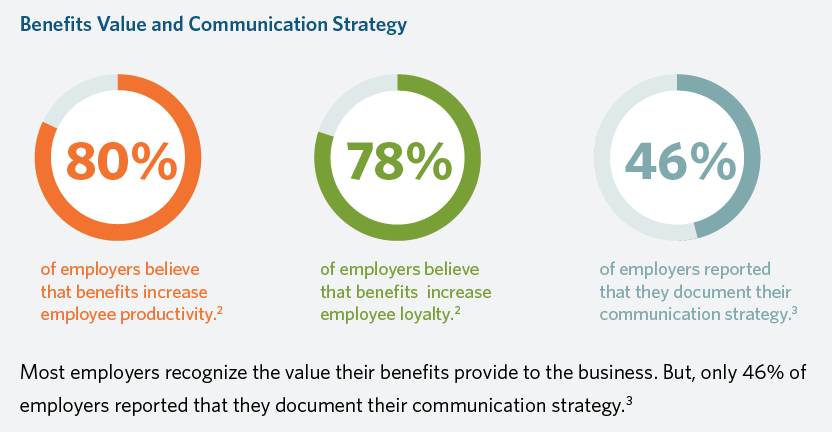
Keeping your communication strategy focused on your people and what matters to them will help you achieve your business goals. For example, if one of your business goals is to decrease the number of health claims around diabetes, your strategy could include targeted outreach that motivates diabetic and pre-diabetic employees to use available health coaching resources.
Think of your strategy as an enhanced roadmap—a means of getting your organization and employees from point A to point B. Each leg of the journey will help you progress to the next as you move toward your overall objective. To map a communication strategy that drives employee engagement, be sure that you:
You shouldn’t communicate “just because.” Just as company goals drive the objectives set by your leadership team, your benefits goals support the broader HR department initiatives.
Once you have a clear definition of what the business and HR are trying to achieve, identify opportunities to support those goals. Are there behaviors you want or need to change? Are there “messy” areas in the employee experience with your benefits that are hampering employees’ ability to support the business? One way to organize your goals is to think in terms of “What do we want employees to know, feel, and do…so we achieve [X] outcome.”
Make sure your goals are focused on employee behaviors that can be measured. That way, you can track progress over time with clear data points. And document your goals, so you have an easy reference point to come back to throughout the year.
Often, we see clients become so focused on the tactics of delivery that the big picture gets lost.
Get to the heart of who you are trying to reach by understanding your audience. After all, 58% of employees want customized benefits options that reflect their personal circumstances. Depending on your goals and size of your workforce, you’ll want to develop 4–6 personas. Personas provide insight into who your employees are, what motivates them, and how to best reach them. They consist of several key characteristics—name, age, relationship status, income, tenure, role at the company—accompanied by a story outlining their goals for their health, taking care of their family, and finances.

Each goal should be aligned with a specific audience. Are you trying to reach executives? Spouses/partners? Employees at corporate headquarters or perhaps those in remote sites? Retirees?
Every communication should have a purpose—usually it’s to get employees to take some action or change a behavior. Once you’ve identified whom you’re talking to and what you want them to do, tailor messages accordingly. For example, new hires fresh from college may not be motivated to enroll in your 401(k) with messages like “Save for your future,” because the time horizon is just too far into the future to inspire action. They are inspired to take action today. A better message for them may be “Everyone else is doing it. Why aren’t you?”
The message is important, but so is the communication channel. Deploy a mix of channels to best deliver the message—your audience will be more receptive to this approach. The right mix of print materials, emails, meetings, videos, etc., is different for every organization. Identify which channels are available to you and how you’re going to reach all your key audiences. For example, you may have to send materials home to reach a spouse, while employees can be reached via email. In Part II, we will go over simple ways you can add variety to your communication mix.
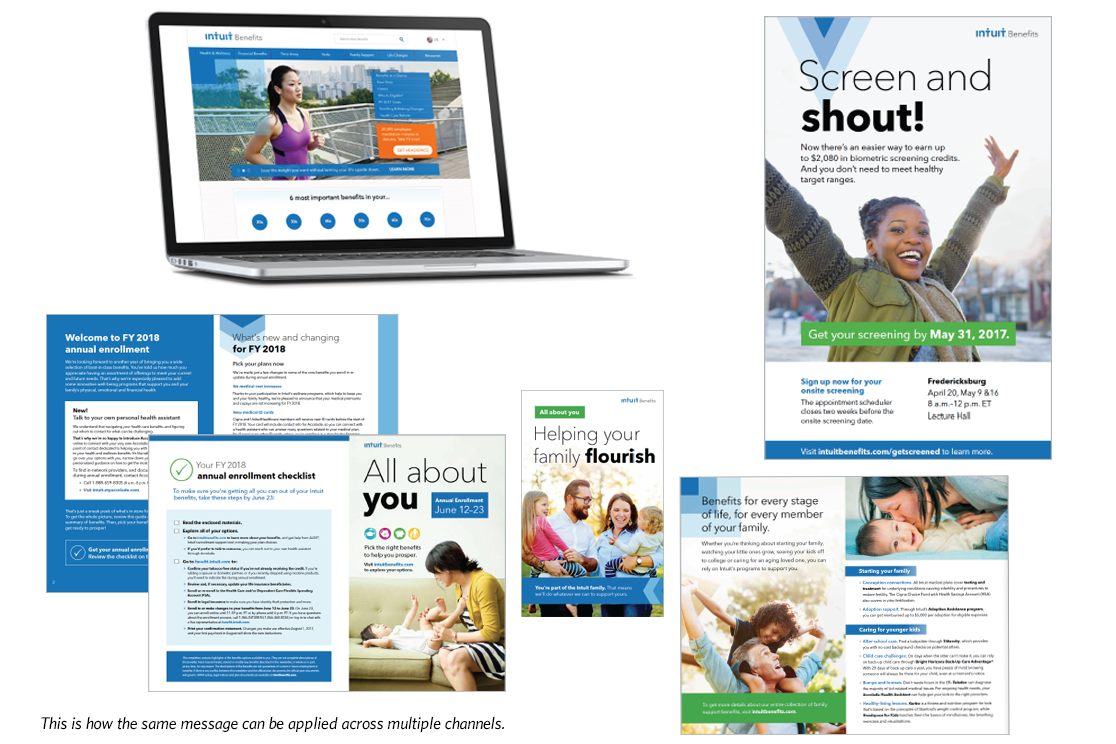
Don't forget your remote workers when thinking about your communication channels. In the past 20 years, the number of organizations offering telecommuting has tripled–to 60%.
You have several easy ways to measure the effectiveness of your communications, and this is an important—but often missed—step when creating a strategy. Remember that every communication should have an associated metric, so take the time to define yours. Consider:
Benefits, by nature, evolve on an annual cycle. Building iteration into your planning process can make those annual changes easier to navigate and help refine your communication strategy. The process requires you to reflect on where your employees are doing well, and adjust your approach in the areas where they’re getting stuck.
So, just as it is important to follow through with your plan, it’s even more important to be open to change.
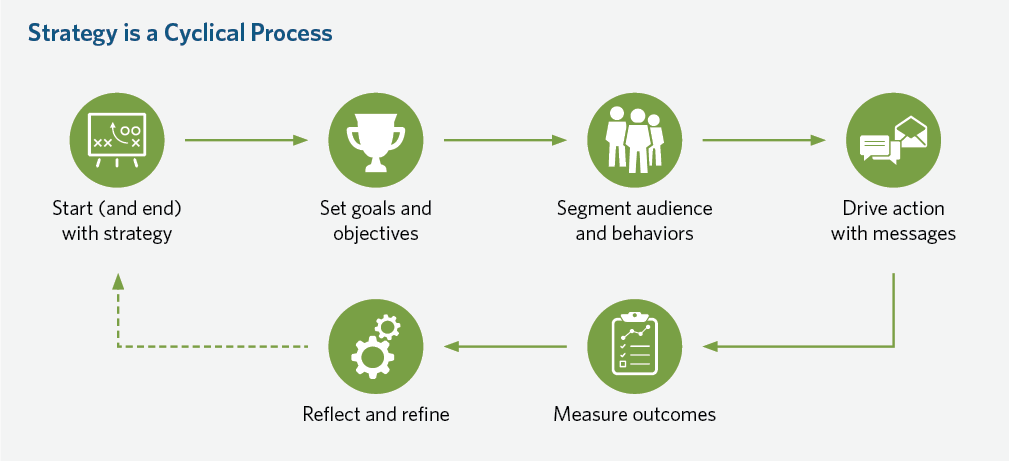
Strategy isn’t just about your approach to communications—it plays a part in your approach to program design, too.
One Fortune 500 client had 62% enrollment in its new medical plan with a health savings account in the first year it was introduced— during a passive enrollment year. We helped our client achieve these results by following the strategic approach to both the program design and communications we outline in this chapter.
The plan was designed in a way that made it difficult for employees to refuse—offering up lower premiums and an incredibly generous HSA contribution.
Communications were targeted based on which medical plan someone was already in, so the messages they received were able to highlight the specific advantages—such as a lower deductible and the savings in medical plan paycheck deductions—to changing medical plans.
The action our client wanted its audience to take—“Make the switch!”—was the headline on all pieces.
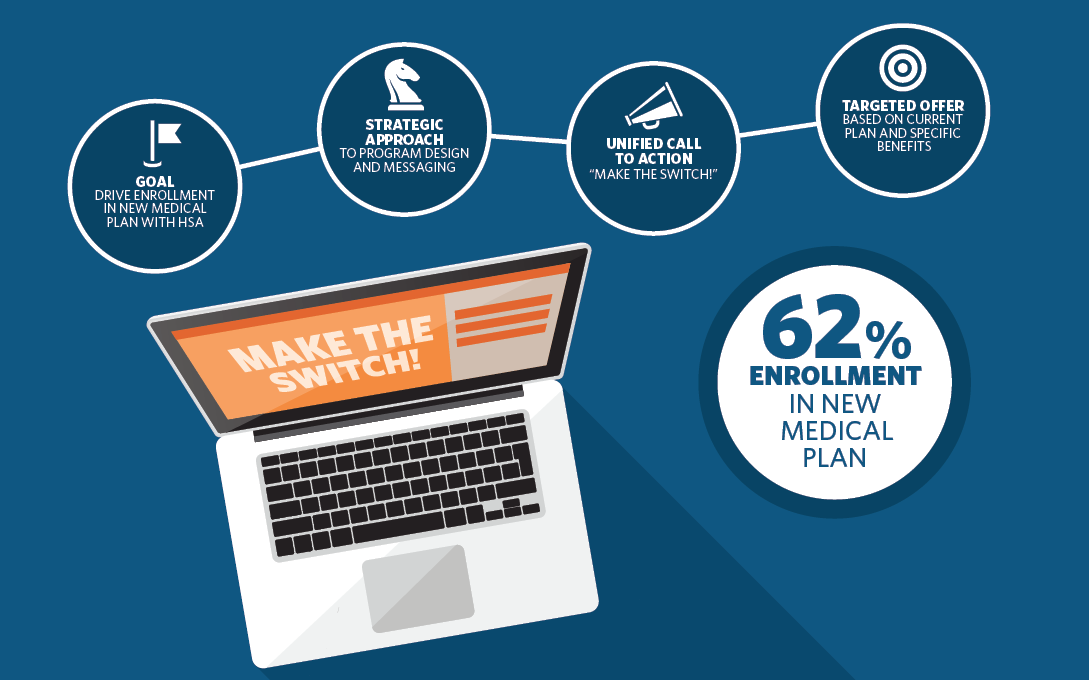
You know what you want to achieve and why. Building your benefits communication strategy helps you get there—faster.
Brand is not simply the logo, color scheme, and tone used in communications—it’s all that and more. It’s the feeling of recognition that someone gets when they see an ad for a familiar company. Or the great experience they recently had with it. Brand builds trust and reinforces reputation. Think about it: A delivery service that promises to meticulously care about your packages cannot have dirty trucks without sending a very mixed message. A bank that says it cares about its customers cannot have 20 people waiting in line with only 2 tellers to serve them. A brand helps create a consistent and predictable experience, which builds trust and loyalty.
To be effective, a company’s brand must be consistent. A company must use its people, its products, and its messaging to consistently reinforce the same positive points it wants to demonstrate.
—Marc Benioff, CEO, Salesforce
In today’s world, you’re competing with an ever-growing array of sophisticated marketing tactics. The sheer number of communications that people receive—notifications, emails, chats, junk mail, text messages, and advertisements everywhere—continues to grow. With all this noise, how do you stand out? A solid brand, consistently applied, prioritizes what you have to say. It’s an easy way for employees to quickly pick out your communications from the masses. After all, if your message is important enough to send, you don’t want people to miss it.
Just as your company brand influences how the public perceives it, your benefits brand influences how employees evaluate and interact with your programs. The external brand is used to sell the company, products, and services; the benefits brand needs to sell employees on the company and help them navigate the programs you offer.
Many companies either forget about their internal audience or treat it as an afterthought. By using your internal brand intentionally, you make your communications more effective and build trust with your employees and their families.
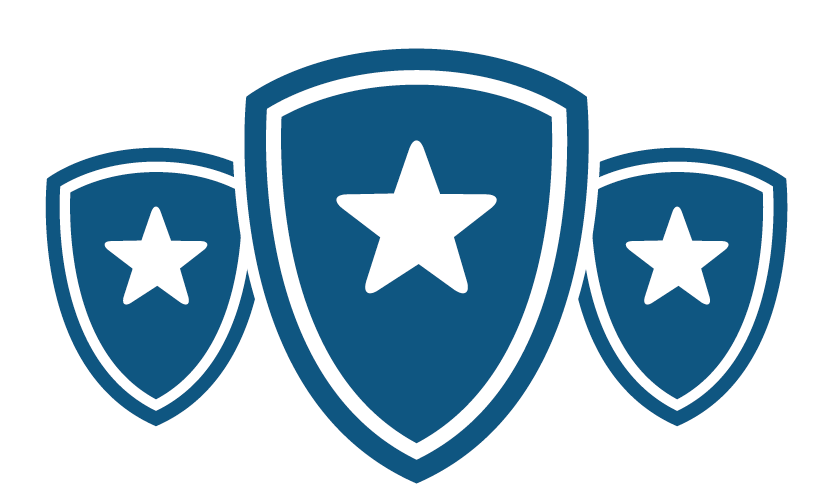
Your benefits communications should be easily recognizable as coming from your company. That brings credibility and helps you break through the clutter to capture attention. Creating a consistent brand experience is easy when you:
To create a cohesive internal experience, your benefits communications should reflect your company’s brand. Build on your company’s brand and style guidelines. Choose colors from your company’s overall brand palette for your benefits communications. Decide which images or subset of icons you want to use, and create an icon library for easy access. Then, document your decisions in a style guide.
The style guide is the foundation of internal and external brand cohesion. It establishes the tone and voice for all written copy, explains what your brand is about, and details how the logo, colors, and images should be used. Some companies have more than one guide—one to address overall brand descriptions and design direction, and another to inform content. Ask your marketing team where you can find your company’s brand and style guidelines.
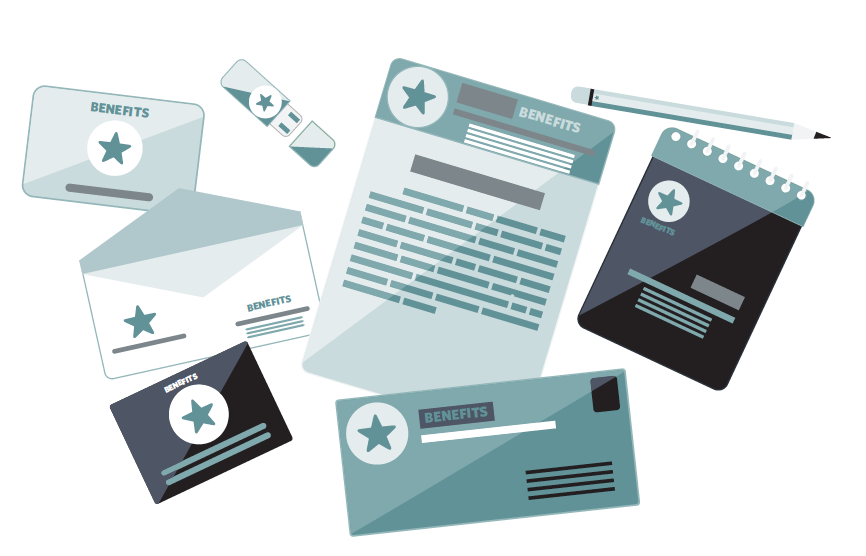
Whether you create something new or use the company brand depends on your marketing team, company size, and resources. If you have enough resources, exploring a benefits brand is worthwhile. Having a unique look is important, especially if your company doesn’t have a naturally warm brand. For example, if your company’s brand doesn’t include photos of people, you may struggle to bring in the humanistic elements that help people connect with benefits information. In this case, you may want to create a benefits brand that includes people—either photos of real employees or stock photos—to bring your communications to life.
Partner with your marketing team or an outside agency to develop a unique benefits brand that aligns with the corporate guidelines. This gives you a leg up on distinguishing your communications from everyone else's.
Whatever benefits-specific brand guidelines you adopt, be sure they cover the points that will be helpful to those creating your communications. Ensure they’re used by everyone who has a hand in developing them—your communications team, your design staff, your web designer, and your vendors and administrators. You’ll save a lot of time if everyone’s on the same page from the start.
When your communications are inconsistent with your brand and don’t reflect your employee value proposition and broader goals, employees don’t recognize them as yours. Some employees may ignore these communications altogether, not realizing they came from your company. We believe consistency is crucial and really pays off in benefits communication—especially for multichannel year-round communication, our 6th key.
A well-known and leading manufacturer of greeting cards, party favors, and more—famous for evoking emotions and actions with just the right words and images—needed a dose of its own medicine to help associates and their families understand and use benefits programs.
Big changes to benefits were coming, and benefits materials needed a “wow” factor so that associates and their families would sit up and take notice. The company wanted to double enrollment in consumer-driven health plans in a single enrollment cycle. Just as no single card in the world can truly explain love, a one-size-fits-all approach to benefits communication wouldn’t get the job done. Diving deep into demographics and plan usage data, Benz built an integrated and multi-year communication strategy to educate families about their benefits.
But, what really set this apart was the amazing visual campaign to bring the content to life. It established the standard for applying the company brand internally.
It was a hit. Enrollment in consumer-driven health plans more than doubled, jumping from 20% to 47%.
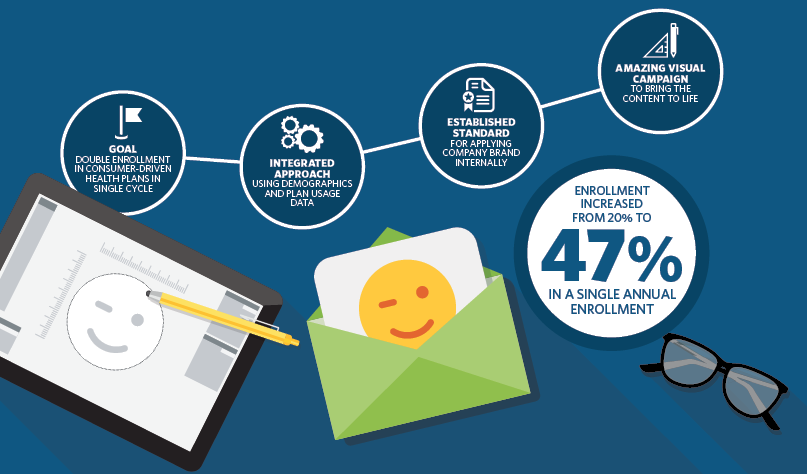
A recognizable and strong brand is not an optional part of your communications—it is crucial to success.
A benefits website is a one-stop shop for employees and families to learn about their benefits and take action. You should have a single website that employees always can access to get the information they need. Ideally, it is available outside the firewall and accessible without a password, and has a URL that is easy to remember (like www.companybenefits.com ). It should be an extension of the entire employee experience and reflect your company’s brand.
Web design is the creation of digital environments that facilitate and encourage human activity; reflect or adapt to individual voices and content; and change gracefully over time while always maintaining their identity.
—Jeffrey Zeldman, founder, List Apart Magazine
A benefits website helps employees see their benefits holistically, rather than as a patchwork of providers and administrators. Without it, they have to go to one place for health and well-being benefits, another place for retirement information, another place for their stock purchase plan, and another system altogether to request a leave of absence. The benefits ecosystem becomes even more complex as you add more programs with one-off vendors. Creating one place for employees to go makes it easier for them to find the information they need.
For you, a benefits website also provides a platform for ongoing communications. Even better, it can save you thousands of dollars in printing and mailing costs. Plus, your website is an effective way for recruiters to show off your programs to potential candidates, who can also use it to quickly assess how your company’s benefits stack up against the competition’s.
For your employees, an accessible and easy-to-use benefits website is a quick way to find the information they need—minimizing frustration, enhancing their experience, and inspiring trust.
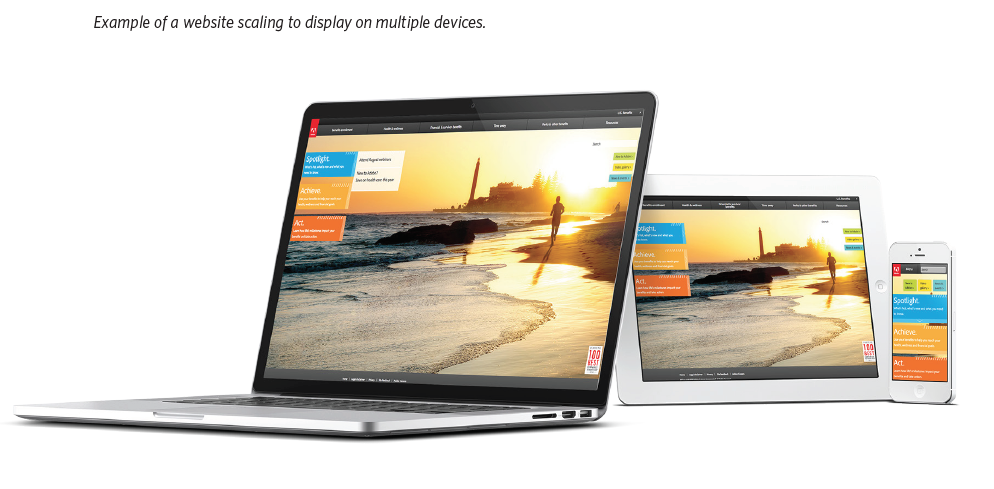
A vital step in helping employees engage with benefits is making it easy to access information and take action. After all, the biggest barriers to any behavior change are complexity and inertia. When your benefits information is easily accessible, employees can find what they need quickly and be motivated to take action.
Unfortunately, many organizations post benefits information only on their intranet and benefits administration portals. Spouses, partners, family members, and recruits cannot access an intranet. And while benefits administration portals are critical for specific transactions, few employees will access them throughout the year for anything other than those transactions.
Placing your website outside the firewall eliminates the need for logins, VPNs, and other barriers. It allows spouses, partners, and other dependents to learn about your benefits, so families can make more informed choices, together.
To stay a step ahead of the competition and meet employees’ expectations, it’s not enough to just make information available on a company intranet, or simply throw a few words onto a generic website and call it a day. You need to have a great benefits website—one that’s aligned with your brand, pulls employees in, helps them access information and act on it, and communicates the value of your benefits.
How do you create a great benefits website? Make sure that you:
A website doesn’t do anyone any good if people can’t get to it when they need to. That’s why it is key for your site to be housed outside the firewall and optimized for a good experience on mobile devices. If, for example, your employee is leaving a doctor’s appointment and wants to access the second opinion referral service that’s included in your benefits, she wants to pull that information up on her mobile device and make the call right then and there.
According to Mary Meeker’s well-known 2017 Internet Trends report, smartphone growth continues to slow—it grew just 3% over the past year—which indicates that everyone who wants or needs a smartphone already has one.7 Meet your employees where they are with a responsive site. A responsive site means that your content will look flawless on any device. We see growth in mobile usage in our clients of all sizes and industries.
For a benefits website to be successful, it must be constantly promoted. Don’t think that just because you build it, your employees will come. Launching your site with a kickoff campaign will get you some initial traffic, but you’ll need a solid communication strategy in place to continue the momentum that will establish your benefits website as the go-to resource when it comes to benefits.
Make your website the hub of your year-round communication strategy, and reference it in all your print materials, email campaigns, social media posts, and other communications as the destination for more in-depth information.
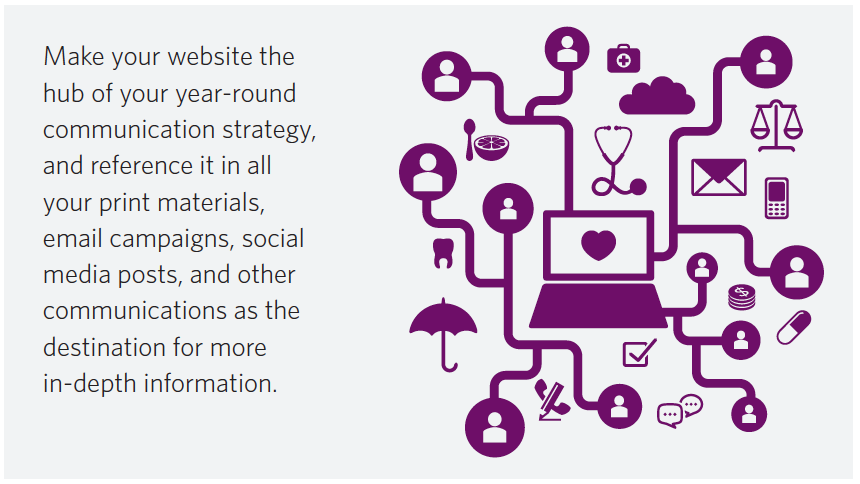
There is no such thing as a one-and-done website. Information on your site needs to be updated often, with new features and refreshed images. If any information on the site is out of date, employees will assume all the information on the site is out of date. One of the many benefits of the internet is how easy it is to continuously refine, tweak, and improve a website’s content and design. Look at search terms, page visits, and user patterns. Use that data to learn how employees are interacting with your site and then fine-tune the user experience.
You can learn important information about your employees by reviewing your site analytics to see how your site is being used.
You can and should use all this information to improve your site. A website is never “done”; it’s a medium that’s meant to be updated and improved regularly. Use your analytics to drive that continuous improvement. You’ll create a better user experience and improve engagement.
Launching a benefits website in phases can help make the project seem a little less daunting. You could start with content about open enrollment and other core benefits. Then, expand over the time to add goal-based content, videos, interactive tools, and more.
If you have a global presence, don’t forget to include your employees who work outside the U.S. A global benefits website provides the infrastructure, tools, and resources to elevate communication in all the countries in which you operate.
In building your site, you can start with the U.S. version, but be sure to plan for additional country pages (or sections) as you map your information architecture and decide how to build the site. For example, when you create country-specific pages, you can ensure that you deliver only relevant information to employees in those countries. That will prevent them from having to dig through information that doesn’t apply to them.
As you build a global site, consider your company’s language policies. Some companies create all pages in U.S. English, while others customize country-specific pages with British English, as applicable. Some even localize their sites, offering pages written in the local language and featuring culturally relevant content and images.
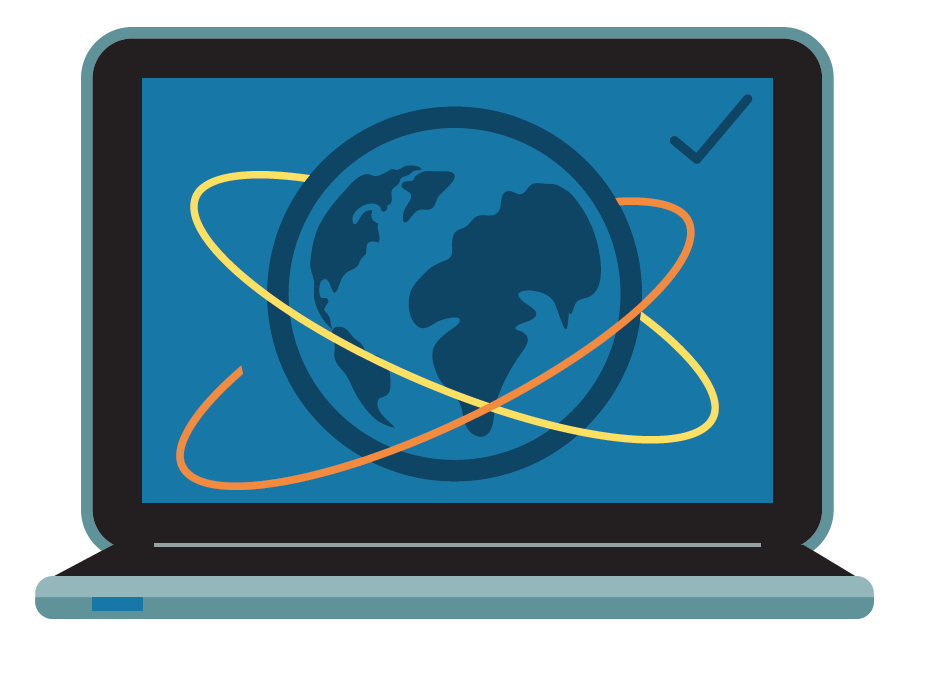
One of our clients, a Fortune 100 Best Company, invested in a global benefits website. This public site provides credential-free access to information for employees, spouses, and family members. Initially, we created the benefits website for U.S. employees only, and over the past decade we have continued to expand and enhance the site to include all the physical, emotional, and financial well-being programs offered to employees and their families across 10 countries. Each country site provides information about the local benefits offerings and features culturally relevant content and images. At the same time, they all reflect a consistent brand, platform, and framework.
We redesign the site regularly, driven by our client’s commitment to continuously improve the employee experience. We took our cues from our client’s approach to product design, and make our decisions about site design and content organization on the basis of in-depth employee feedback gathered through one-on-one interviews and focus groups.
Content features for the U.S. site include targeted information for employees and family members across six age bands, as well as goal-based content to help users quickly identify benefits that can help them reach their personal goals—e.g., “Fit into your skinny jeans,” “Enjoy your retirement,” and “Stop living paycheck to paycheck.”
Employees love it—the latest analytics show that the site gets almost 14,000 unique visitors every month.
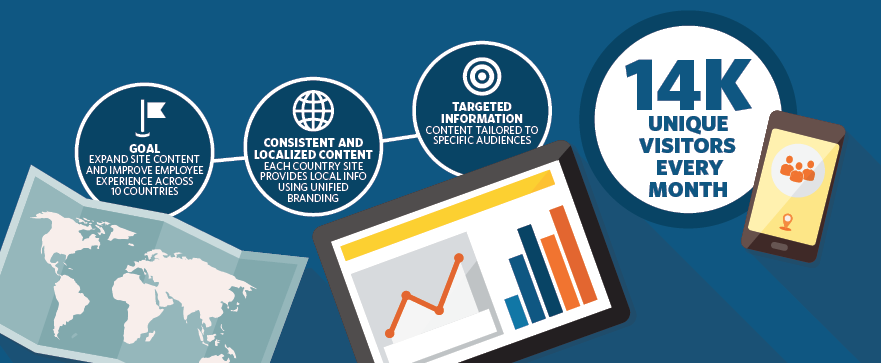
We know there’s a complex ecosystem of plans, programs, carriers, and administrators in benefits. A custom benefits website provides your employees and their family members with one place to go for all their benefits information needs.
Feedback is essential for gaining insight into—and developing empathy toward—the very people for whom you’re creating solutions. It’s vital to understand what’s important to your employees, what motivates them, what their goals are, and where they get stuck.
We can’t just sit back and wait for feedback to be offered, particularly when we’re in a leadership role. If we want feedback to take root in the culture, we need to explicitly ask for it.
—Ed Batista, executive coach, Stanford Graduate School of Business
Everyone wants to feel heard. Listening is one of the most important things you can do as a leader. It’s more than just hearing what people like and don’t like; it’s an opportunity for you to evaluate your current approach in a whole new light—whether it’s something as small as a word choice or as large as introducing a new medical plan.
Listening will help you get results faster and more easily. For example, you could invest significant time in restructuring your wellness program steps to make them easier to complete—only to discover that it wasn’t that the steps were preventing people from completing the program, but rather that the reward for completing them wasn’t enough of a motivation.
The type of feedback you’re looking for—how does someone feel about X, or how does someone interact with Y—can help determine the approach you should take to collect it. Here are a few methods that HR and benefits teams can readily use:
Focus groups: Assembling a cross-sectional representation of your employees for an interactive group discussion will offer insight into the reactions and opinions you can expect from your larger employee population. It’s easier than you think—just send one email to your employees to recruit participants, and then reserve a conference room and a half day to facilitate the sessions.
Interviews: One-on-one conversations are a great way to build the rapport necessary to get candid and honest insights. They’re especially useful when you’re discussing sensitive topics, like concerns new parents might have. We recommend talking to at least 20 people who are representative of the topic at hand (e.g., reach out to employees who just returned from parental leave if you want to talk to new parents). And keep the conversations to no more than 15 minutes. You can get through about 5 questions in 15 minutes, so have them prepared in advance.
Observation: Simply watching how employees behave or interact with your programs provides substantial insight. What employees say they do and what they actually do often differ. You can observe employee behavior in a number of ways, including usability testing of your benefits website to see how people navigate the site and whether or not adjustments need to be made; interactions with a prototype; and reactions following the launch of pilot.
Prototypes: A prototype can be anything—a drawing, poster, group experiment, even a crude model. It can even be a simulation of what you want someone to experience. It’s the thing you review and experiment with before you do the real thing. Let’s say you’re launching a new HR Portal. Use a prototype to test assumptions about how content should be grouped. Observe how users interact with the content, and see how easily they find information or take desired actions with the prototype. In this case, you might write each benefit on a card and ask employees to group the cards. You’ll see how benefits are categorized in their minds. The goal is for employees to experience your idea, not just hear about it during a presentation.
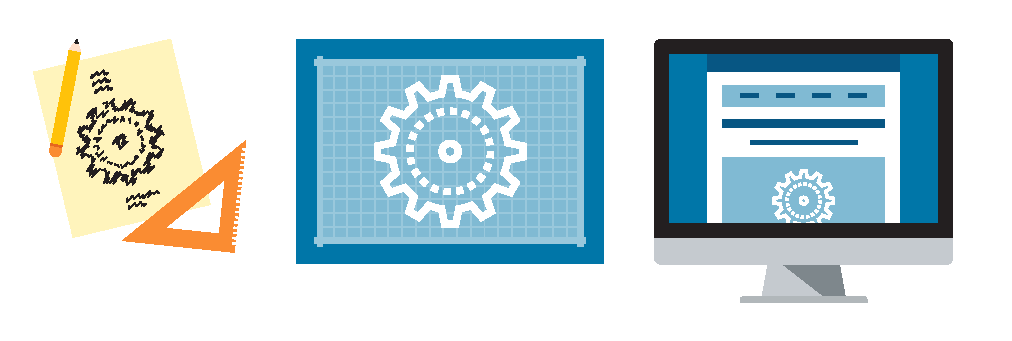
Surveys: Quick to develop and deploy, surveys are great for capturing very specific information about a large number of people. To get even more detailed insights, surveys can include branching logic, which directs employees to a specific line of questioning on the basis of their answers to prior questions.
Don't let concerns around your ability to implement feedback prevent you from gathering it. We know you can't—and shouldn't—act on every single piece of feedback you receive, so you'll need to determine how to prioritize. Are there themes? Do you strongly believe something needs to be done? And, if you end up implementing someone's feedback, let them know!
HR and benefits professionals have perfected the art of creating surveys. In fact, they’re often the default for eliciting employee feedback because it’s far less intimidating to conduct a survey than it is to lead a focus group, have one-on-one conversations with employees, or conduct usability testing. But we encourage you to try other methods to get a richer level of understanding. When you have a conversation, allow people to speak freely. When you do usability testing, observe how they actually interact with a website or mailer. You’ll get more nuanced and specific information, naturally. Follow these guidelines, and you’ll be collecting employee feedback—in person—in no time:
For some topics, like Medicare enrollment, the group you talk to will be tightly defined. For broader topics, such as attitudes toward health care or saving for retirement, you’ll want a good cross representation of age, tenure, and gender to account for multiple viewpoints. For focus groups, you want no more than 10–12 people per session, so there’s time for everyone to share their opinion. With interviews and user testing, it should be just you and the employee.
Sometimes, surveys are sent to broad audiences. That can work for general topics like “How satisfied are you with X?” But we also encourage you to use surveys to get more specific feedback. For example, if you’re curious about what motivated someone to try a new program, or enroll in a certain medical plan, ask only those people who actually tried the program or enrolled in the plan. Since what people say they do and what they actually do are often different, you’ll have a better understanding of their motives when you survey only those who have actually completed a certain action.
Thank the participant or participants for joining you, and remind them of the context in which their insights may be used. That will allay any concerns they may have about confidentiality and sharing their opinions. Provide an overview of the subject you plan to cover, as well. This can be something as simple as: “Hi, I’m Mary from the HR department. We’re trying to better understand what types of financial education would be helpful for you as we determine what programs to put in place.” With one-on-one interviews and user testing, offer a little bit more about yourself; it will encourage employees to open up. If you’ll be recording any of the activities, make sure to get consent before you record.
In focus groups, there’s no need to have everyone introduce themselves—although we do suggest name tags, in case employees would like to direct a specific question to another participant.
With surveys, a quick 1- to 3-sentence introduction at the top of the survey will suffice: “Thank you for your recent participation in XYZ Company’s Annual Benefits Enrollment. So that we can continue to improve our offerings and processes, we invite you to complete this brief survey. It should take no more than 5 minutes of your time.”
Leading questions are ones that prompt the desired answer. Your moderator or interviewer should have adequate knowledge of the topic to keep the conversation on track and avoid prompting specific answers when following up. “Do you think HSAs are a good way to save money?” is a leading question. “What’s your opinion about HSAs and saving money?” is not. One quick tip— leading questions can often be answered with a simple “yes” or “no” (which is another type of question you’ll want to avoid!).
With usability testing, you want to see how people navigate a website or interact with content or a product. Your key insight will be how they get to the information you ask them to find or the action you desire them to take, so be extra careful not to drop any hints. And as hard as it may be, resist the urge to jump in and help guide them along.
By their very nature, surveys provide more protection against leading questions because they don’t involve an interviewer or moderator.
In focus groups, you’ll want to make sure everyone has time to speak. Often, you’ll have one or two more outspoken employees who can quickly dominate the conversation. To help prevent this, direct questions to certain participants as a way to encourage—and give space for—others to contribute.
During interviews, moderating means sometimes having to rephrase a question if you’re not getting answers of substance.
In usability testing, if the person you are observing has come to a complete stop, then that’s good information, too, and resist the urge to help. You’ll know how people would interact with the prototype, were it real.

With larger focus groups, arrange for another team member, in addition to the moderator, to be present to take notes. That person is unnecessary in one-on-one interviews if the interviewer is comfortable taking notes.
Usability testing is most commonly associated with websites. It’s a very effective way to learn whether or not a proposed navigation structure makes sense to your employees. But it can also be used on prototypes. Or to discover if one description or explanation of a complicated concept is better than another.
The goal of usability testing is to give employees a sample of something that you’re thinking of putting out into the world, and then to see how they interact with it. It could be an illustration of how a health savings account and a high-deductible health plan work together. Or a chart that shows how an employee stock purchase program works. Or, perhaps, a proposed website site map. Show it to employees. Ask them to interact with it. Then, watch what they do. Can they find the information you asked them to locate on a website? Maybe you have two versions of something that explain the same complicated concept. Do they gravitate to one over the other? Body language alone can tell you a lot about what people are experiencing.
Whatever your user testing involves, you’ll want to record the interaction. That way, you have another opportunity to watch the interaction and observe what you may have missed while you were in the room—and share it with others. Technology has made this surprisingly simple to do. All you’ll need is a laptop with a camera or a webcam in a conference room.
One year after the launch of an enhanced parental leave program, a client discovered that extended time away from work brought problems that neither the HR team nor employees could have anticipated. Employees returning to work were struggling to reintegrate into their departmental roles. Even simple things, like what they should do on their first day back at work, weren’t clear. Should they just show up at their desks and start checking emails? How should they adjust to their new reality and schedule with a new baby at home? How should they get up to speed when they return? What about the sensitive issue of breastfeeding?
It was obvious that more support was needed for returning from a long leave of absence … but more of what? Our client wasn’t even sure where to start. So, they decided to go back to the drawing board and re-evaluate the program structure and touch points. At first, HR leaders thought that flexible working arrangements would be the solution, so they tasked the Global Benefits team with implementing that change. However, the Global Benefits team proposed that they instead take a few extra weeks to make sure this was the right solution. To better understand how to help employees transition back to work, they gathered feedback directly from program participants. Over a period of two weeks, they interviewed 15% of the employees who had taken a leave of absence of at least two months.
Surprisingly, when employees were asked what the company could do to make them feel more supported, they rarely mentioned flexible schedules. What they wanted was a more structured—and empathetic—process for returning to work. And that process needed to start with managers.
The team used that feedback to design and launch a customized “return to work” program. They hoped this new program would help to create a smoother transition for employees returning to the company after being away for an extended leave.
The program was well received—almost 350 employees expressed interest in the first six months it was available.
Talk to your employees to get honest feedback about what’s holding them back—and learn what changes you can make to help them move forward.
Keeping things simple is exactly what it sounds like—it’s about making things as easy as possible to understand. Despite the best of intentions, this is often where HR teams fall short—because when you’re knee-deep in knowledge, it’s easy to forget that not everyone knows the topic as well as you do.
The ultimate pitch for an era of short attention spans begins with a single word—and doesn’t go any further.
—Daniel H. Pink, The New York Times best-selling author focusing on business, work, and behavior
At some point in their career, benefits and HR professionals are bound to encounter a sobering realization: Many of their employees are completely lost when it comes to understanding health care and financial information.
Not only is it really hard to figure out how your health care works, in general, or how best to manage money, but it’s also difficult to navigate all the jargon used in the benefits world. Terms like “premium,” “out-of-pocket maximum,” and “ESPP” are thrown around with a casualness that belies their complexity. Over time, it’s easy to miss the quizzical expressions that appear on employees’ faces and just continue with business as usual.
Until that confusion becomes blindingly clear.
Maybe you’re tipped off by the employee who’s honest enough to admit he doesn’t know what an HSA is. Once the realization hits, you may start over-explaining every little thing—just to make sure you cover your bases. When you launch a new program, you might devote several pages to it on your benefits website. And, for good measure, you’ll create a glossary, an FAQ, and an employee guide. While all this information is definitely comprehensive, is creating a lot of materials for your employees to wade through the best use of your time—or theirs? Probably not.
A recent report made headlines with its click-bait worthy headline, which stated that the average attention span of a human was less than that of a goldfish. How we stack up against goldfish—while interesting—isn’t the point. The takeaway is that the average person tunes out after 8 seconds. So, it’s critical to make content simple to read, scan, and absorb.
According to The National Assessment of Adult Literacy, only 12% of adults have proficient health literacy. This means that almost 9 out of 10 adults lack the skills needed to manage their health and prevent disease.9 Health literacy is an individual’s ability to process, understand, and act on health information— to make appropriate choices. It has a direct correlation with health outcomes.10 With these low levels of literacy, crafting clear and simple communications is imperative.
One of the most common mistakes we see is too much detail in communications about benefits. With too many messages, there’s no way for employees to quickly and easily digest the information. So, they’re more inclined to skip the communications altogether. Instead of throwing all your program-related details into the mix, break up complex topics into smaller, more manageable pieces.
For example, when one of our clients launched their employee stock purchase plan (ESPP) a few years ago, they had a hard time articulating two of the plan’s greatest features: the “look-back” feature and the “reset” feature. Since both of these features offered big financial incentives to employees, our client felt compelled to go into great detail about how each feature worked. We eventually convinced them that the “less is more” approach would be more persuasive than a long-winded explanation that read like a college dissertation. The result: two short, snappy sentences that described each feature, and this employee feedback: “This is by far the best, easiest explanation of the ESPP I’ve seen. THANK YOU!”
When you make the effort to simplify language and organize your content, employees notice! Here’s some of the feedback our clients received after we redesigned their benefits websites.
Creating simple communications can have a big impact on employee engagement and, ultimately, healthy and productive employees.
The health care and financial industries are cultures unto themselves, with languages all their own. Unless you work in these industries—or your work revolves around them—you may not be familiar with the terminology they use. The same goes for your employees, who rely on you to “decode” jargon. For example, another way to articulate an “out-of-pocket maximum” is to provide the context that employees will need to understand the term. In this case, you could say “the most you’ll pay in a year.” Of course, you’ll want to make sure you use that terminology consistently across all communication pieces.

Remember that most people don’t know benefits as well as you do. So, even if it sounds simple to you, the 22-year-old intern who sits two rows down probably has no idea what “ideal asset allocation” means in terms of how she should structure her 401(k). Before using terms and phrases that may seem obvious to you, casually test them with coworkers in other departments. A good rule of thumb is to write so that an eighth-grader will understand what you’re saying.
The best way to quickly catch—and keep—employees’ attention is to structure communication so they can easily scan it for information that’s relevant to them. This will make it much easier for employees to absorb what they need to, and take action. Checklists are a great way to do this.
Make sure each communication piece has a clear call to action—it’s the “so what?” of your communication. At first glance, employees should understand what they need to do next and how to take action. If it’s not clear, they’re more likely to do nothing.
Don’t make employees figure things out on their own. It’s your job to tell a complete story. If you can make connections for them, they’re more likely to engage. Examples: “This plan saves me $X,” or “This plan is better for me because of Y.”
The most effective way to consolidate benefits information is with a benefits website—one that’s built outside the firewall without password protection. A dedicated website becomes your one-stop shop for all benefits information, which saves your employees the hassle of remembering dozens of provider URLs.
Information design is the practice of presenting information in a way that makes it easy to understand. It’s not solely about looks; it’s about organization and structure. A great perspective to keep in mind when designing is “don’t make me think.”
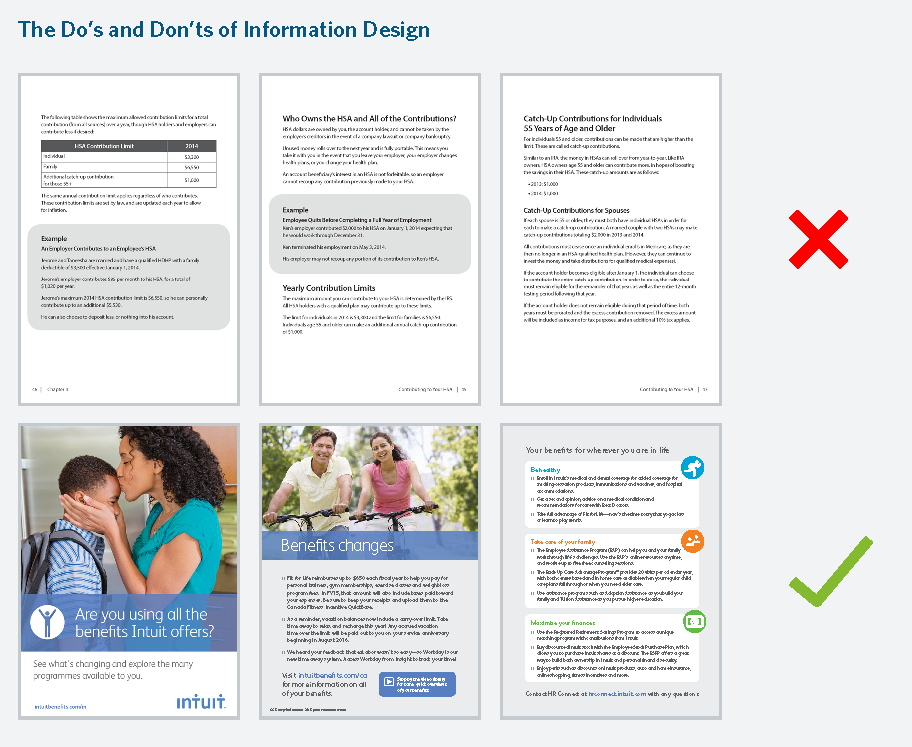
When a high-tech client asked us to create some buzz and excitement around a new suite of perks designed to appeal to employees in all life stages, we employed a true marketing approach. Key to the success of the campaign was ditching the usual HR and benefits jargon in favor of fresh, punchy language that would resonate with the company’s male-dominated engineer population. And appeal to other employees, as well.
Instead of developing one communication piece to announce all the new benefits, we produced a series of unique—and unexpected—pieces, such as stand-up displays and cafeteria placemats, to supplement their existing benefits website, posters, emails, digital displays, and team meetings. The goal was to engage employees in the new benefits and reinforce the employee value proposition. So, each piece of the campaign conveyed a single message with a clear call to action:
The campaign was a hit. Employees described the communication as “fresh” and “hip”— adjectives not commonly associated with benefits communication. In fact, 80% of our client’s employees actively enrolled during a year of passive enrollment. Keeping it simple got employees’ attention and inspired them to learn more about their benefits.
A multi-channel, year-round approach to communications means utilizing a variety of communication channels to address different learning styles and keep the conversation going throughout the year.
You can have brilliant ideas, but if you can’t get them across, your ideas won’t get you anywhere.
—Lee Iacocca, former chairman, Chrysler, and former president, Ford Motor Company
Until recently, employees heard about benefits from their employers only about once a year—usually during open enrollment. Yet they were expected to remember how their benefits plans worked for the next 12 months. Now that we’re asking people to take a more active role in their health and finances, it’s not enough to remind them once a year to do all the things we want them to do.
Communication shouldn’t stop after a program is implemented, and it shouldn’t happen only once a year during enrollment. Frequent communication is essential for keeping benefits top of mind and reinforcing the employee value proposition.
When you’re creating communication plans for new program launches, make sure they include education goals and vehicles for the first year. If you’re launching a Health Savings Plan, for example, an ongoing education campaign for the first year could include the following components: quarterly webinars, a series of tip sheets, and integration into the new hire orientation. Be sure you review and update your campaign annually to ensure you’re meeting employees’ needs.
In the previous section, building an iterative process was emphasized; it’s important to deliver your message via multiple channels. Your communications should be tailored to meet the needs of your workforce and reflect the different ways people absorb information. For instance, think about how you approach a news website. Do you go to today’s headlines? Most popular? Breaking news? Local news? Videos? Do you shy away from links to videos? Using multiple media channels helps ensure your message is seen. Maybe your email got lost in someone’s inbox, but then they saw a poster with the same message on their way to a conference room. It’s all about full coverage.
75% of employers say keeping employees and families engaged in their benefits year-round is their greatest communication challenge. However, the lack of engagement could be linked to the frequency of communication, since the majority (64%) also say they only communicate with employees once a year during open enrollment.
Your path to a multi-channel, year-round communication plan doesn’t need to be overly complicated. Incorporate these techniques as you plan your communications for the year:
People have short memories. If you want them to engage in your programs when they actually need them, you’ll need to provide reminders and updates throughout the year. Your strategy will determine which topics to cover, the time of year to talk about them, and how often they need to be repeated.
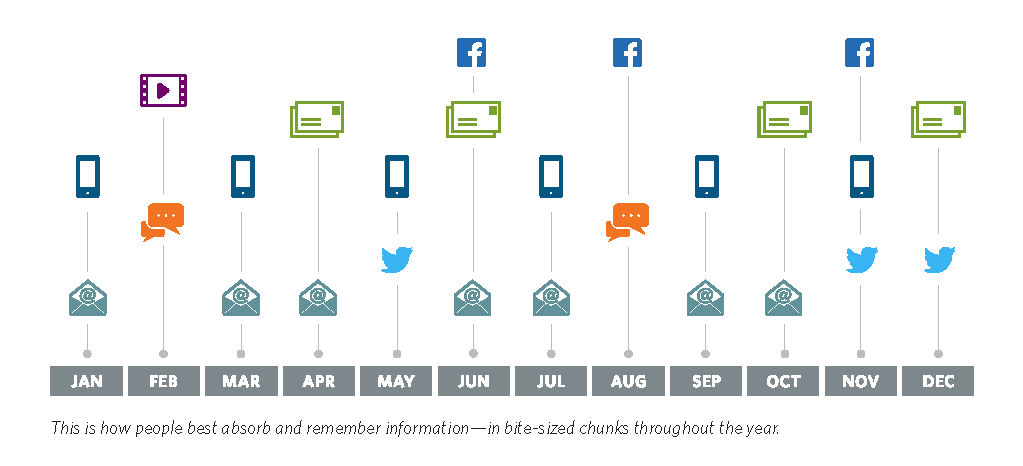
Channels that “push” employees to take action include text messages, automated notifications, and any other messaging that extends from you, the employer, to your employees. Channels that employees “pull” from offer information to help them answer questions or make decisions. They include your benefits website, videos, and decision-support tools. It’s a self-service model. Leveraging a combination of push and pull media channels will help you drive better results.
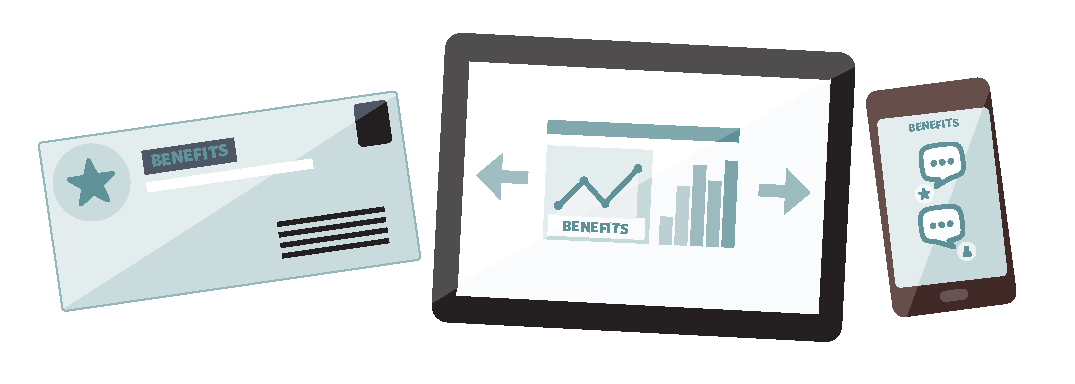
Before you roll out video, a blog, text messaging, or any other new communication channel, plan for how it will fit into your overall communication ecosystem. You can start with answering some basic questions: Will it replace or duplicate another channel? How will it complement and integrate with other channels? How will you promote this new channel so that employees know when to use it? How will you support this channel over time?
| Traditional | Online and Interactive | Unexpected |
| Guides | Intranet | Infographics |
| Newsletters | Benefits websites | eCards |
| Postcards | Text messaging | |
| Employee meetings | Social | Podcasts |
| Health fairs | Video | Large format installations |
| Posters | Webinars | Peer champions |
| Tip sheets | Decision-support tools | Anything you can dream up! |
One of our “100 Best Company to Work For” clients sets a flawless example for multi-channel, year-round communication. With the foundation of a strong strategy, brand, and benefits website, their communication has evolved over the years to include frequent updates and campaigns delivered across many channels to reach both employees and family members. The result: exceptionally high engagement with benefits, from wellness and health care to retirement and financial programs.
In particular, the commitment to their wellness program communications has created remarkable results over a 5-year period:
This type of change doesn’t happen with one-and-done communication. Every January kicks off with a new year campaign and health reminders. In the spring, health fairs start onsite, including biometric screenings and open enrollment education. A big enrollment campaign in early summer focuses on engagement across benefits (not just what’s changing). Communication continues through the summer and fall. In addition to robust information available on an external website and frequent home mailings to reach family members, campaigns are also promoted via email, manager tip sheets, intranet news articles, and on-site posters and signage. Also integrated are the wellness and health concierge mobile apps which help drive people to the right programs.
This combination of channels and frequent touch points ensures employees get to the right programs at the right time.
The most successful communication strategies leverage the strengths of multiple media channels throughout the year.
Casting a wide net doesn’t necessarily catch more fish when it comes to communication. Targeted messages can help get the right message to the right person at the right time.
Anticipated, personal, and relevant advertising always does better than unsolicited junk.
—Seth Godin, author, entrepreneur, marketer, and public speaker
You have an incredibly diverse population to engage in the complicated world of benefits. Diverse in terms of age, family situations, motivations, and earnings. You also have an enormous amount of data available to you about the people who work for you: their personal information, their salaries, where they live, and their family status, as well as information about the benefits in which they participate. There have been great strides made recently in advanced analytics capabilities for HR, so we encourage you to ask your vendors what they can do. Use this data to help your employees make good decisions and to support the programs you’ve put in place.
That’s the essence of targeting and segmenting communications—using the data you have to make your communications more relevant to specific populations of employees. Communications are most effective when they’re very focused messages that nudge employees to take the next step, make better decisions, or use your plans and tools better—in a way that is relevant to them. What’s more, information about our self, unsurprisingly, disproportionally captures our attention. It’s about customizing the messages to make them more accessible, engaging, and applicable.
A one-size-fits-all approach to benefits communication won’t allow you to create materials that are relevant and meaningful to everyone. However, there are some occasions when broad-based is the right approach, such as when you have a global “inform” message and the actions people need to take do not differ among groups. If you’re not making many changes during open enrollment, for example, one general communication piece will suffice.
You can deliver targeted messages through multiple channels (think: multiple versions of a postcard, text, or email). Or you could provide different ways for employees to access information on a website, based on how they self-identify.
Targeting remains a big opportunity. Just 11% of employers communicate by demographic group, and only 36% communicate by benefit behavior.
Moving from generic to hyper-relevant messages can make a big impact on the effectiveness of your communications. Targeting doesn’t have to be overly sophisticated or complicated. But there are a few “rules” to follow:
The beauty of targeted communications is that they allow you to be very specific about who you’re talking to. Make sure you clearly define your audience, and have a plan in place for getting the data files you need to send communications to a select group.
As we discussed in key 5 (simplicity), it’s important to be very intentional about how you structure your call to action so that it’s clear to employees what you’d like them to do. Do you want them to sign up for health coaching? Invest the funds in their health savings account? Enroll in your employee stock purchase plan.
As we discussed in key 5 (simplicity), it’s important to be very intentional about how you structure your call to action so that it’s clear to employees what you’d like them to do. Do you want them to sign up for health coaching? Invest the funds in their health savings account? Enroll in your employee stock purchase plan?
You already have a lot of data available within your payroll system, such as age, health plan, income, etc. To kick it up a notch, ask your vendors to supplement your data with consumer data. This will create a more complete picture of your employees’ needs and wants, and help you target more precisely.
Versioning is one of the simplest and most under-used strategies for benefits communication. It’s intended for large but distinct groups, and it’s a simple way to deliver the most relevant information. Personalization is used when you have something specific to say to an individual. It’s a bit trickier to implement, but it’s highly effective.
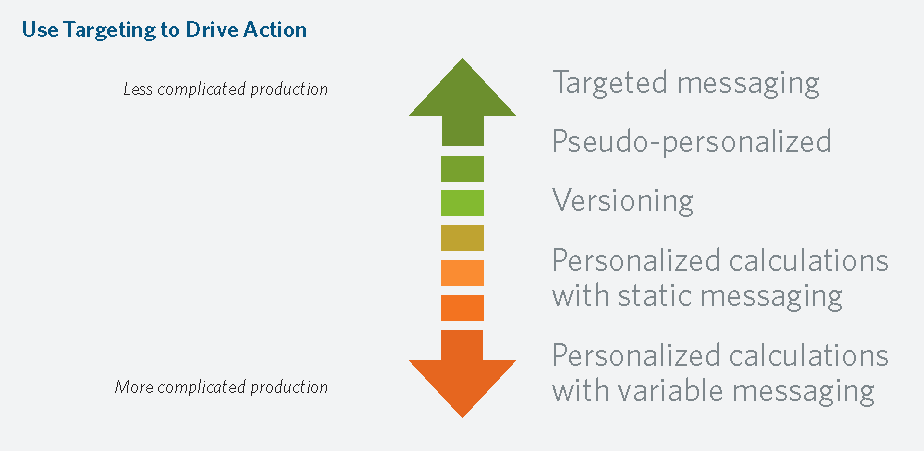
These methods of targeting work for both print and online communications. They’re based on the data you’re using to segment messaging to your employees.
When a large, prestigious university needed to communicate a significant health plan change, they knew it would require an approach that was different from their standard open enrollment communication plan. The university hadn’t implemented any changes to their health plans, or the cost and design of those plans, in more than a decade. So the introduction of a new health plan—and elimination of the three existing medical plans—required delicate handling to ensure a smooth transition.
To get ahead of confusion and angst about changes to benefits, we developed targeted communications that allowed employees to quickly see how their current plan compared to the new offerings. The communications highlighted key areas, such as deductibles, premiums, and out-of-pocket maximums.
We mapped out a targeted multimedia campaign (including print, online, and video) that featured specific messages about unique replacement plan options and steered members toward the new plans that most closely matched their current benefits. This helped employees review their choices more easily; at the same time, it nudged them toward the new plans.
We replicated this targeting on the website, in enrollment videos, and at employee meetings— so messages throughout the campaign were consistent and personalized.
Despite the significance of the changes, they were generally well received, and the new health plan strategy met its enrollment goals, with more than 45,000 enrollees.

To create communications that have maximum impact, be thoughtful about whom you want to reach, how you can help them engage, and what action you want them to take.
The expression “employee experience” is used widely and broadly without much consensus on what it means. For us, it means looking at the big picture—connecting programs for employees, beginning with the day they walk in the door and continuing until their last day of work—and beyond. It’s all about what the employee actually experiences throughout that journey, and putting everything available to them into context.
When the ship misses the harbor, it’s seldom the harbor’s fault.
—Janet Lapp, R.N., Ph.D., Best-selling author and motivational speaker
Employers know that benefits serve a large role in employee satisfaction and engagement. However, there is a large disconnect between knowing what needs to be done, and then getting your benefits programs to where you want them to be to increase satisfaction.
The employee experience starts when a prospective candidate first decides to leave her current job to join your organization, and it doesn’t end until her last day of work with you. Make sure your communication strategy covers the whole experience by following these guidelines:

Think of a persona as the embodiment of key characteristics that help you better understand your employees. Build personas to determine the correct approach for engaging employees, based on what they need, what they do, their preferences, the challenges they face, and other relevant information. When you design for and communicate to a persona, you’re no longer looking at a 34-year-old male who makes an average of $65,000. Instead, you’re looking at Sean, who is recently married and covers his new wife on his health plan. He has some student debt, so he’s balancing paying that off while also saving for a home. He’s interested in programs that can support those needs. Which of these individuals is easier to connect to and gear communications toward?
It’s important to map the employee experience from start to finish to fully understand all points at which you can engage employees and where your actions can impact their overall experience. For a benefits rollout, this means thinking through the impact as you plan and design your new program, the program implementation, the enrollment or sign-up process, and the year-round support strategy.
Beyond benefits, this includes the experience employees undergo as they evolve from candidate to new hire to first-year employee to, finally, seasoned worker.
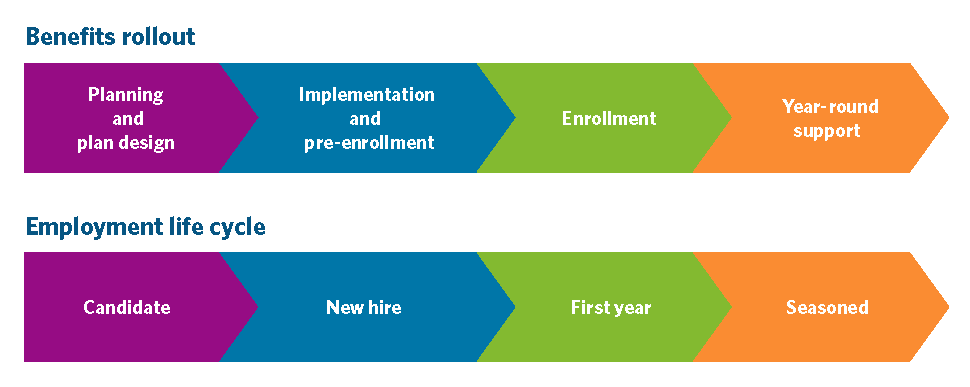
Benefits should have a prominent role in your new hire orientation and new hire kits. We know you have a lot of information to convey to new employees, all while they’re trying to do the most important thing of all—learn their new job. So as not to overwhelm them—and to tee them up for success—keep them focused on the immediate actions they need to take (e.g., enrollment deadlines and knowing about your benefits website). And be sure to close the loop with them before it’s too late to do something critical, since remembering to sign up for a legal plan might not be top of mind when they’re trying to figure out your new systems and getting to know their coworkers.
Automatically enroll employees in programs you know are good for them—like a 401(k) plan. Only 21% of employers automatically enroll employees in their 401(k) plans. In the longer term, keep the “easy” choice in mind as you change your benefits program lineup.
With the best of intentions, employers offer many different plans and programs. They frequently package similar programs together when communicating about them, assuming this will be enough to help employees understand how they’re used together. But it’s not. To successfully market your full range of benefits offerings, you need to make it easy for employees to see how they’d use your programs in real life by tying the benefits together to tell a story. Present scenarios, such as “when life gets messy,” “as my family grows,” and “when I need extra support for my health.” It’s a nice way to break out of the benefits silo and help employees use the right benefits at the right time.
Different audiences need different experiences, at different times. Internal communications are often overwhelming for employees. With many separate websites and places to go for information, they’re inclined to give up on their search for benefits information because they don’t know where to find it. When a large employer spun off from their parent company, a legacy tech giant, they wanted a fresh new website befitting their sleeker, hipper company culture to attract right-fit candidates and facilitate the onboarding process. We recognized that different audiences would be going to the site for different reasons—job seekers to check out the benefits offered and new hires to act quickly on things they needed to do, like enroll in benefits. Plus, they had an executive population with a special set of exclusive benefits that the company didn’t want to publicize. We realized the experience had to be different for each audience. To support each of these distinct populations, we created four versions of the same elegant benefits website. This was fairly easy to do— it required a personalized homepage with a specific login, and then content was slightly targeted to reflect the login used to access it. Recruiters were happy—this allowed them to showcase all the great programs the company offers, without displaying information that wasn’t appropriate for all audiences. And the HR team was happy, because it provided a streamlined way for employees to learn what they need to do and then immediately take action.
Employees are the heart of your business. Make sure the experience you offer them reflects that.
You should have a budget allocated specifically for employee benefits communication. It should be large enough to cover the internal and external resources you need to support your optimal communication plan. The amount you’ll need to spend depends on how aggressive your goals are, the size of your employee population, your internal team’s capabilities, and the communication infrastructure you already have in place.
The budget is not just a collection of numbers, but an expression of our values and aspirations.
—Jacob Lew, 76th United States Secretary of the Treasury
We rarely encounter a company that couldn’t benefit from communicating more frequently and more intentionally with its employees. Most organizations know their employees need actionable information about how to understand and use their benefits correctly. Still, very few companies have a communication plan in place that enables the universal goal of getting employees better engaged in their benefits. Why? The answer shouldn’t come as a surprise. The biggest impediment to more effective communication is resources—time, people, and money.
The cost of effective communication is incidental compared to the cost of the benefits themselves. Companies with a few thousand employees or more can usually make a huge impact by dedicating less than 1% of the cost of benefits to communication. Yet most organizations continue to under-invest.
Even if you don’t have enough budget to support effective communication, you should create a plan for doing more. This book will help you understand the business case you can make for getting more, and how your partners can help drive successful benefits communication.
Typically, we see 3 junctures when companies need to re-evaluate the resources they invest in benefits communication to improve results.
1. You're growing: As organizations grow from 1,000 to 5,000 employees, many start to develop a more robust, strategic, and resourced employee communications infrastructure— one that supports all HR and internal communications. As companies mature, their entire communication ecosystem needs to evolve to support a large organization. At this juncture, it’s time to move beyond the homegrown solutions that worked when the business was smaller, and define their point of view on operating with the right tools and talent to support internal communications.
This is also an ideal time to adopt a strategic approach to benefits communications. This means setting the foundation, as Book I of this ebook series outlines: documenting your strategy, creating a recognizable brand, and building a website as the single go-to resource. And then putting a year-round communication plan in place. By taking a proactive approach to benefits communications during this growth phase, you ensure benefits remain a strong part of the employee value proposition. You also pave the way for your team to provide consistent, sustainable communications going forward. Investing
2. Employees aren’t aware of your benefits: If you didn’t start to invest in benefits communication as your organization grew, you may not have the infrastructure to meet the communication needs of a large organization. Often, benefits communication gets left behind, even as an organization’s internal communications evolves. This gap can leave benefits teams feeling the pain of employees who are confused or having benefits that are under-utilized and under-appreciated. If you find that your benefits team or your HR call center is spending a good amount of their time fielding employees’ benefits questions, or if you find that no one is using the benefits programs you’ve worked so hard to implement, then it’s time to invest more resources to support the approach outlined in our 10-key framework.

3. You're experiencing big changes: When big benefits changes are in the works—such as a new health plan rollout, a new HR technology launch (e.g., Workday), or a merger or acquisition— it’s important to invest in communicating those changes in advance. It’s human nature to resist change, so whether you’re adding new benefits, introducing a new wellness strategy, or making changes to existing benefits, effective communications will be key to establishing trust and driving desired results during times of change. These big changes will also give you an opportunity to create the right infrastructure to support ongoing communication long after the reason for the change has passed. Use them as an “excuse” to build the right foundation for employee communications and create a year-round cadence.
In addition to knowing when it’s the right time to invest, you’ll also need to determine where to invest and what resources you need. The right approach is largely dictated by your company’s goals and size, and the existing communication. The 10 keys we outline in this book map the best practices for every organization—and you can customize them for your organization. Use the table below to help you determine where to allocate your resources. It’s based on the foundational keys (strategy, brand, and website) we covered in Part I, and it includes the marketing approaches that support year-round communication.
Once your foundation is in place, you’ll need to budget accordingly for the following:
Getting the word out about what you offer is the most important step you can take toward ensuring a successful benefits program. As a benefits leader, you may inherently know the value of communication and engaging employees. But, to get leadership buy-in and ongoing organizational support for benefits communications, you need to build a business case for the resources that support them.
The easiest way to see the value of communication is to take it away. The principle of loss aversion from behavioral science shows that we feel the loss of things we already have more acutely than the pleasure we gain from acquiring something new. Use it to illustrate how vital benefits communication is to your employees’ lives. When you meet with your leadership team, ask them to consider a few scenarios that illustrate the challenges employees might encounter if you stopped communicating about benefits altogether.
Here’s how to build your case for the value of doing more:
This is where the strategy you developed plays an important role—and part of why it’s the very first key in our 10-key framework. When you clearly explain to leaders what you are trying to achieve and why—and how communications can get you there—you paint a picture they can understand. It’s all about framing the conversation in their terms instead of yours, so they can relate more easily to what you’re saying. Examples of framing in ways leadership can identify with include: savings that result from reducing health care claims when employees participate in wellness programs or when they move to a high-deductible health plan, and reduced turnover when employees are happy at work and stay in their jobs longer because they feel supported by your company.
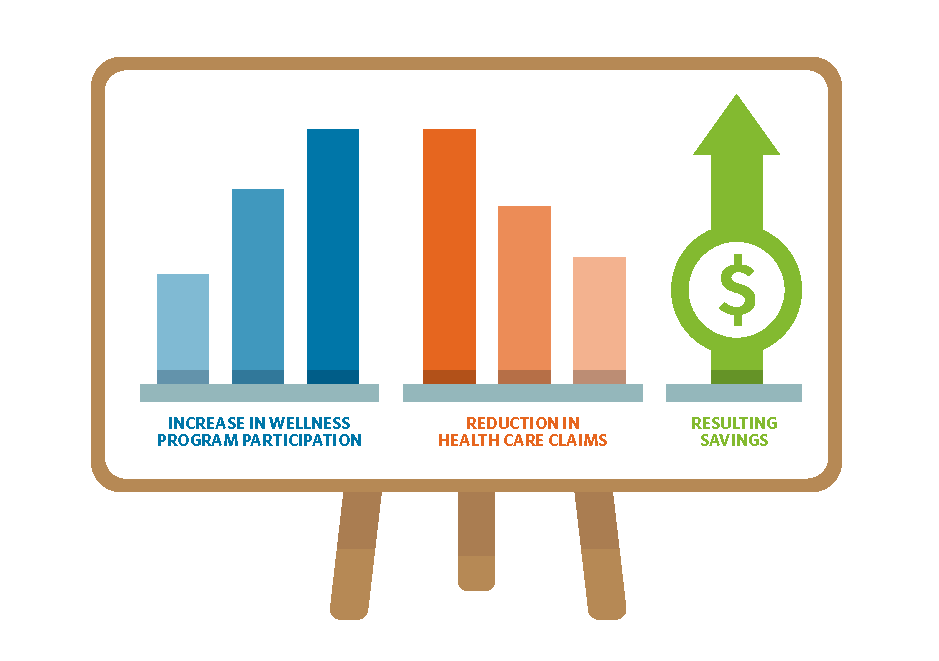
Budget decision-makers respond well to statistics and data that make a strong case for the effectiveness of the approach you’re advocating they spend money on. Therefore, make sure your business case includes meaningful data that bolsters your claims. When you do, it gives the people in charge of your budget the hard data they need to make the decision you want.
Data points that are especially persuasive include those around productivity. While productivity is often hard to quantify directly, you can position it around stress management—e.g., “49% of employees are concerned about X, making it hard to focus at work.” Or, “78% of employees believe benefits increase their loyalty to the company.”
Engagement data points are great to include, too. For example, data collected from a recent joint study by Quantum Workforce and Limeade shows that employees who believe their employer cares about their health and well-being are 38% more engaged. What better way to show employees you care about them than by advertising all the programs you offer to support them?
Below is a list of reputable sources for data points such as those mentioned above:
All HR leaders want the company they support to be viewed as a company of choice to work for. The 2017 Gallagher Best-in-Class Benchmarking Analysis for Large Employers found that best in- class employers are much stronger in taking a comprehensive employee communication approach—35% of best-in-class employers versus just 18% of those that didn’t make the list. This shows that strong communication and viewing employees as a vital audience pay off in terms of becoming a top employer.
Segal Benz partners with leading employers who put their people first. Seven of our clients made Glassdoor’s 2018 Best Places to Work list and we have 5 current clients on the latest Fortune Best Companies to Work For list. Their commitment to and efforts toward benefits communications help put them there, and is a boon to attracting and retaining top talent.
Storytelling is one of the most powerful mechanisms for getting your point across. Our brains aren’t wired to remember facts and logic for long periods, but they can retain stories. Stories create tension and mystery, so we focus our limited attention on the story at hand so that we don’t miss what’s coming next.
Stories also allow us to convey concepts that the audience may not be familiar with, in terms they are familiar with. The sample stories below outline the risks involved when employees don’t know about programs available to them. To grab your leader’s attention and gain the buy-in you want, build a traditional story arc with real people and real details.
Sample Scenario 1: Imagine an employee dealing with a serious illness or personal crisis— something your benefits are specifically designed to support. Except this employee isn’t aware of the programs available to him because they’re only communicated once a year, during open enrollment. Therefore, he spends hours managing it alone, when a simple visit to a website or phone call might have resolved his problem much faster and more effectively.
This technique is effective because individual stories are more powerful than general group statistics. It’s much easier to relate to and care about one person than it is a faceless, nameless mass.
Sample Scenario 2: Think about the long-term impact of employees not knowing about or using benefits programs. How would employees feel about the value of their total rewards without any information about them? How would a lack of benefits appreciation affect engagement, retention, and recruitment? What would happen to employees’ overall physical, financial, and emotional health?
The employee value proposition (EVP) is the reason why employees want to work for you … and what they agree to give you in return for doing so. The EVP is more than the salary, career opportunities, additional compensation, and benefits package you give employees. It’s also a reflection of your company brand and values. It’s what sets you apart from other employers. Benefits are typically a large part of the EVP. Do you have the best time-off program in town? Amazing family perks? Those are crucial elements of your EVP—if employees know about them. Make that case when you talk to senior leaders.
Promoting your EVP is more important now than ever before. According to PwC’s 20th Annual CEO Survey, 77% of CEOs see the availability of key skills as the biggest threat to their business.
Investing in benefits communication makes a difference in becoming an employer of choice.
In the fall of 2015, we were introduced to one of the country’s largest providers of home care workers. This employer really cares about their employees, who were primarily low wage earners, and wanted to make sure they knew about and enrolled in their medical plan to avoid the individual mandate penalty. Our client needed help prioritizing where to focus limited resources to make the biggest impact.
While they had a website in place, it was more of a repository of information and not at all user-friendly. Content was also stale, and it was positioned around what the company could do for employees, instead of around employee needs. We helped our client rearrange and rewrite existing content so that employees could find what they needed and feel supported.
To reach a very diverse workforce, we used several communications channels and created targeted messages for different parts of the workforce, such as home health aides, nurses, and office staff. To promote open enrollment and clearly drive decisions, we also developed targeted online content and postcards for different employee populations.
The campaign was a hit! Enrollment in minimum coverage plans (for the lowest-paid employees) increased by 77%, and enrollment in the high-deductible health plan (offered to salaried field employees and office staff) increased by 26%.
Building on the success of their first year, this employer focused their efforts the following year on ensuring employees were registered with their medical plan carrier, so that they were supported year-round once they were enrolled in the plan. The campaign leveraged the company’s successful recruitment tagline, “I Love What I Do,” with this theme for its employees: “You Love What You Do, Now Take Care of You.”
In addition to helping the company exceed their benefits goals, these combined efforts over two years helped this employer rank on the Glassdoor Best Companies to Work For list for the first time in 2018!
You have amazing ideas about what benefits you want to provide to employees and the experience you want them to have at work. Don’t let your budget hold you back.
Your partners are everyone around you who can help you reach your goals. This includes your internal team, members of other departments, and external consultants and vendors.
Ask for help. Not because you are weak. But because you want to remain strong.
—Les Brown, motivational speaker

Benefits communication is a team effort. Identifying your partners and knowing how to best work with them will help you be more successful. Let’s take a closer look at them.
External agencies and/or freelancers: You engage with these resources for one of two reasons— either you don’t know how to do something yourself, or you’re pressed for time and capacity. Expertise and speed come at a premium, and you should be prepared to invest in those resources. However, the investment also comes with the sense of relief that it’s going to be done right, it’s going to be done on time, and you don’t have to manage the work. You should expect these partners to make your life as easy as possible.
Benefits administrators, carriers, and vendors: You share a common goal with these partners: to boost participation and engagement in the benefits plans and programs they offer employees. They want employees to use their programs and have good experiences. To that end, they provide many free communication materials about their programs to help employees engage. However, it is up to you to ensure their communications materials meet your goals. These partners may provide a great starting point for communications that can be customized and branded for your needs.
You should expect these partners to collaborate with your designated communication expert— whether it’s someone on staff or from an external agency—and to defer to your communication choices. You do not have to use their templated and off-the-shelf communication plans.
Internal benefits team: Your team plays a big role in communications. Is your internal team structured appropriately to support communications work? Do you have the right resources in the right roles? Communication efforts go more smoothly when there is a dedicated point person to manage the work, including someone to manage the internal review process. The more communications you produce, the more important it is to have a dedicated resource and a process for managing your communications.
Key stakeholders in other departments: Do you have a good relationship with senior leaders who can be advocates for the important work you’re doing? What about key stakeholders in organizational areas outside of Human Resources? Finding the right partners on those teams will go a long way toward ensuring your communications are successful.
Your internal communications team is an important partner. Only a portion of employee-facing communication is about benefits. It’s the job of your internal communications team to manage everything coming from the company that goes to employees, and it’s not an easy task.
By understanding their viewpoint, what priorities they have, and how they want to support benefits teams, you can better partner with them to make your communications shine.
Understand what’s important to your executive team. Because that’s the viewpoint that your internal communication partner has. Organizational priorities should drive your benefits goals to some extent. Keep that in mind when you think through what you want to communicate, and you’ll find it easier to win their support to make it happen.
Bring your internal communications partner in early. If you do, they’ll be your biggest advocate and champion your cause. When you make sure they’re in the loop from the get-go, internal communications can prioritize resources on your behalf. They can point out potential communication “minefields” before you’re too far along to change direction. And they can even lend a hand in drafting and delivering communications. An internal communications professional’s worst nightmare is hearing, “Hey, I have this huge payroll change rolling out next week. Can you help me write an email or something?”
Be open to their point of view. There will be differences of opinions among benefits professionals and communication professionals. What’s key is finding the right balance. Have the benefits team take the lead on defining the most important points to get across, and ensuring content accuracy. Let the internal communications team focus on the messages and the communication plan. That way, the communications benefit from everyone’s expertise. This also creates a partnership that encourages both teams to continue to engage with one another.
Treat them as equals, not as gatekeepers. In some organizations, there’s a perception that every communication has to be reviewed by a designated person on the internal communications team. That viewpoint suggests that benefits teams are giving up all the power they hold before they even get to the table. Meanwhile, internal communications teams may feel like they have to say something about every piece because they are being treated like gatekeepers. Even a slight change in the way you ask for their review can help shift that balance of power. “Here’s what I’m planning to send; I’d like your advice” is much more collegial than, “Can you review and approve?” At the same time, it sends a powerful message. Behavioral scientist Robert Cialdini says that when you ask people for advice, they take a step forward toward you, psychologically, to put themselves in a collaborative state of mind. Conversely, when you ask for an opinion, people take a step back to reflect, and they feel less invested in the outcome.19 The bottom line is that there is no one gatekeeper (or shouldn’t be!). As the owner of the benefits programs, you are ultimately responsible for any employee questions or feedback your communications generate. So, don’t give up that power
Recognize that there may be times when what you want to communicate isn’t a priority for the organization.Internal communications teams try hard to accommodate content from all departments. But there will be times when certain initiatives will take precedence and are prioritized over yours. Let’s say the finance team at a large retailer is rolling out a new point of sale system for their stores. That week, making sure everyone has information about the new system is going to be more important than promoting the Employee Assistance Program.
Ask your internal communications team to schedule regular monthly or quarterly communication summits.Communication summits are an ideal way to generate a holistic view of the communication landscape within an organization. Typically, representatives from all major departments attend and share their priorities. They can determine where to focus their energies and where there could be synergies when they’re aware of the initiatives that are in place in other departments. And, with a deeper understanding of everything employees are being expected to absorb and act on, you can adjust your communication plan accordingly.
Benefits teams absolutely cannot take on any more than they’re already tasked with. Therefore, to get the results your organization needs from its communications, you must increase the capacity and the ability of your team to deliver—not just try to stretch what you have now. That typically means taking one of three paths:
Remember:
You need a partner with a specific skill set to develop and execute an effective communication strategy. This could be a specialized agency, an HR consulting or outsourcing firm’s communication practice, a broker/consultant who has a communications practice, or freelancers (there are many who specialize in employee benefits communication). This is often the quickest path to results because you will have expert, dedicated resources who are there to help you succeed.
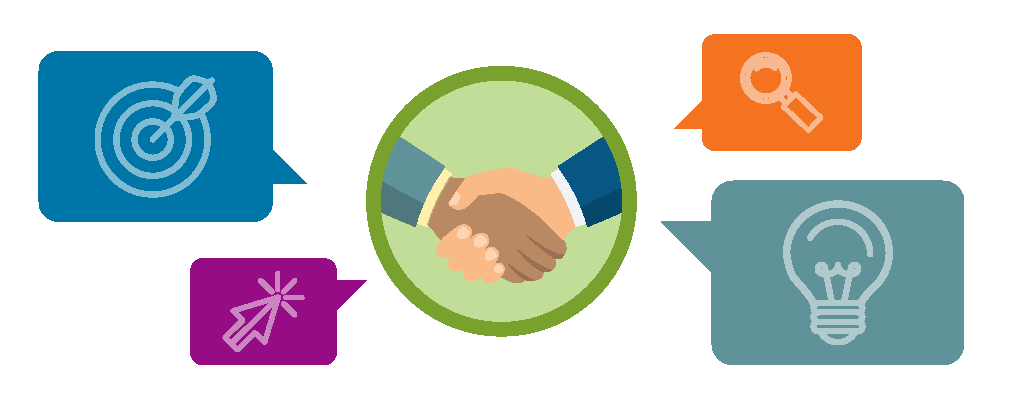
This could mean allocating your team’s time differently. Perhaps you can outsource a nonstrategic function currently handled by your team members to free them up to focus on communications. Or it could mean collaborating with your internal communications department to get the needed resources. This option may take more time (and you may still need some outside support), but it could allow you to create an internal team capable of delivering strong, year-round communications.
Your vendors—administrators, wellness program vendors, individual plan providers, and others— have a lot to offer for employee communications. You can also explore point solutions to support communications and engagement. Point solutions are products and services—such as decisionsupport tools, videos, and interactive experiences—that are designed to solve a very specific problem. The companies that provide them are enhancing their tools and capabilities every day. But keep in mind that these solutions need to be integrated into an overall strategy. So, you’ll still need experts to develop and deploy that overall communication strategy.
How collaboration across internal and external team creates success. Our longest client relationship is with a prominent Silicon Valley tech company. We’ve watched their support model evolve over the years to utilize a vast network of external vendors and strengthen relationships with internal partners.
Every year, we re-evaluate their budget and strategy to make sure they’re aligned with their goals. Their budget has grown each year as their needs and the complexity of their programs have increased.
During our first engagement, we developed their benefits brand. Each year since then, we work with their internal marketing team to refresh it. Because the internal marketing team is included at the beginning of this refresh, once it’s complete and they sign off on it, they trust our team to implement it appropriately, without having to review communications in their design phase. This reduces the time needed to create, review, and ultimately get a deliverable out the door.
We also support their global benefits website, working closely with HR team members in other countries to ensure content is accurate and up-to-date.
HR teams regularly hold vendor summits so all their partners can determine how to better work together and where there might be synergies, or where they can streamline processes. Over the years, we’ve established good relationships with this client’s vendors, which has allowed us to bring all vendor communications into the brand. Often, these vendors give our client a credit toward their communications because they know that when they’re done right, the communications will drive more engagement in their programs.
This client is a prime example of a company that encourages direct conversation among its internal and external partners. This dialogue contributes to programs and communications that are more clearly on brand, align with the EVP, and ultimately succeed in driving engagement.
Don’t go it alone. You have a vast ecosystem of partners, vendors, and internal resources that can help you bring your communications to life.
We partner with organizations that value their people first.
We are proud to be part of the Segal family.